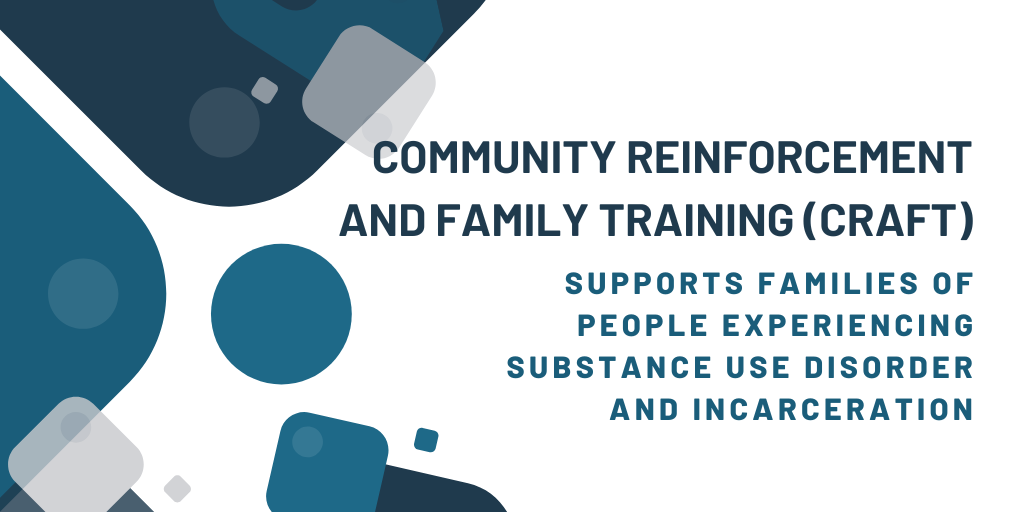Many therapeutic approaches to substance use disorder (SUD) focus on teaching the individual to change their own behaviors and thinking patterns to help them stop using substances and maintain abstinence or safer use (e.g., cognitive behavioral therapy, relapse prevention therapy, and others).[i] One approach, however, focuses specifically on the family members of the person using substances and how they can encourage their loved one to seek help and create an environment and relationship that supports recovery. This method, Community Reinforcement and Family Training (CRAFT), has proven to be highly effective at getting individuals who misuse substances into treatment and helping them maintain recovery.[ii]
Created in the 1970s by Robert Meyers, PhD, CRAFT is an intervention exclusively for the family members or friends of people with problematic substance use who have previously chosen not to engage in treatment. It is often used in tandem with Community Reinforcement Approach (CRA), an intervention for the individual with SUD that focuses on making changes and finding positive reinforcements in their environment and community in order to support their recovery.[iii]
An Evidence-Based Approach Born from Personal Experience
Dr. Meyers grew up in a home impacted by substance use and watched his mother struggle to help his father, who chose not to get treatment for his drinking. In adulthood, upon returning from serving in the Vietnam War and beginning work in treatment settings, Dr. Meyers saw countless members of other families desperate for ways to help loved ones who chose not to get treatment for SUD. He had been trained in CRA and thought about how to apply the principles of that intervention—finding positive healthy connections and replacements for substance use activities in one’s community—to a family relationship. He then developed an approach aimed at the loved ones themselves and how they could create an environment that encouraged recovery. “This intervention is all about helping the family—the spouse, parents, or other family living in the home with someone they love who doesn’t want to go into treatment,” says Dr. Meyers. “We teach them how to change their environment and use motivation and reinforcement to help their loved one.”
CRAFT is designed to help family members of individuals with SUD—known as “concerned significant others,” or CSOs—gain skills to help and motivate their loved ones to address their substance use and take care of themselves. “No one knows more about the individual’s behavior, triggers, and strengths than the people who live in their household,” says Dr. Meyers. “With CRAFT, we teach CSOs how to use this information in a motivational way to increase the chance of their loved one entering treatment.”
Straightforward and Adaptable Intervention for CSOs
Family members can connect with a CRAFT provider through a variety of channels. Often, treatment programs will offer this intervention to family members of a person with SUD who chooses not to engage in treatment. People can also seek it out for themselves by finding a CRAFT-trained provider [PDF] (see more about becoming trained in CRAFT at the end of this article). During CRAFT training (ranging from 4 to 14 weeks), CSOs might receive support in learning how to do the following:
- Develop new skills to cope with old problems
- Understand why people misuse substances
- Use reinforcers and rewards to encourage the loved one to stop or reduce substance use
- Allow their loved one to experience natural consequences of misuse
- Ensure personal safety
- Practice self-care during difficult times
CRAFT trains CSOs on how to change the way they interact with their family member in order to motivate the person with SUD to address their substance use. This type of approach may be very useful for families of individuals who are reentering their home after incarceration, as it helps address counterproductive family dynamics and create an environment that supports recovery.
A Culturally Responsive Approach
One of the great benefits of CRAFT and CRA is how adaptable they are to families from many different cultures or familial structures. This is one of the reasons these interventions are so popular at Intermountain Centers, a large treatment and service organization in Tucson, Arizona, according to Chief Executive Officer Rose Lopez.
Intermountain Centers offers a wide range of programming and works closely with courts, in addition to receiving referrals from health plans for individuals reentering the community following incarceration. About 25 percent of Intermountain Centers’ clientele is involved with or has had justice involvement. Every new client, including those from justice settings, is screened for SUD using the Drug Abuse Screening Test (DAST-10) and offered appropriate services. CRAFT is an essential component of the organization’s SUD treatment offerings, which include residential treatment for youth and adults.
Intermountain Centers holds service contracts with every Native American tribe in Arizona. In their licensed mental health clinic in the Tohono O’odham Nation, the CRAFT model has been very successful and well received by participants. Because they focus on an individual’s family environment, CRA and CRAFT are highly adaptable to different cultures and communities. At the Tohono O’odham Nation mental health center, for instance, families participating in CRAFT have incorporated important cultural elements, such as art, dance, and singing.
“The CRAFT model really embraces the social and cultural aspects of a person’s life as replacement for substance [use],” says Lopez. “It’s a really great thing to witness. It can be hard to succeed in areas that are remote with limited employment, education, or opportunity. Through the CRAFT model we work with families to find hope and opportunity to replace substance use behaviors with better options, such as engagement with a community garden, art, or other community activities.”
Positive Outcomes and Accessible Training
Research shows that CRAFT is among the most effective family interventions for SUD. Dr. Meyers, along with many other researchers, has been studying the effectiveness of CRAFT for decades. Recent research found that around 7 in 10 individuals who previously chose to go untreated ended up entering treatment after their loved one completed CRAFT. These individuals were both more likely to enter treatment and do so more quickly (i.e., they had a lower “time to treatment”) than individuals whose loved ones only attended Al-Anon or Nar-Anon family groups.[iv] CRAFT is effective for both alcohol and drug use. Research from 2002 found that 59 percent of CSOs trained in CRAFT had loved ones who misused substances enter treatment, compared to 27 percent of those who only had Al-Anon/Nar-Anon family group facilitation. When CRAFT was combined with an aftercare component for CSOs, they were even more successful, with almost 77 percent seeing loved ones enter treatment.[v] Dr. Meyers and Jane Ellen Smith, PhD, have written several books on CRAFT, including the new The CRAFT Treatment Manual for Substance Use Problems, and they offer training to providers through their website.
References
[i] Cassandra L. Boness, Victoria Votaw, Frank J. Schwebel, David I. K. Moniz-Lewis, R. Kathryn McHugh, and Katie Witkiewitz, “An Evaluation of Cognitive Behavioral Therapy for Substance Use Disorder: A Systematic Review and Application of the Society of Clinical Psychology Criteria for Empirically Supported Treatments,” preprint, PsyArXiv, November 17, 2022, https://doi.org/10.31234/osf.io/rpwh9.
[ii] William R. Miller, Robert J. Meyers, and J. Scott Tonigan, “Engaging the Unmotivated in Treatment for Alcohol Problems: A Comparison of Three Strategies for Intervention through Family Members,” Journal of Consulting and Clinical Psychology 67, no. 5 (October 1999): 688–97, https://www.researchgate.net/profile/Robert-Meyers-4/publication/232968813_Working_with_Family_Members_to_Engage_Treatment-Refusing_Drinkers_The_CRAFT_Program/links/0deec536d417799880000000/Working-with-Family-Members-to-Engage-Treatment-Refusing-Drinkers-The-CRAFT-Program.pdf; Meyers, Robert J. Meyers, William R. Miller, Jane Ellen Smith, and J. Scott Tonigan, “A Randomized Trial of Two Methods for Engaging Treatment-Refusing Drug Users through Concerned Significant Others,” Journal of Consulting and Clinical Psychology 70, no. 5 (October 2002): 1182–85, bit.ly/3I98xgw.
[iii] Robert J. Meyers, Hendrik G. Roozen, and Jane Ellen Smith, “The Community Reinforcement Approach: An Update of the Evidence,” Alcohol Research & Health: The Journal of the National Institute on Alcohol Abuse and Alcoholism 33, no. 4 (2011): 380–88.
[iv] Kimberly C. Kirby, Lois A. Benishek, MaryLouise E. Kerwin, Karen L. Dugosh, Carolyn M. Carpenedo, Elena Bresani, James A. Haugh, Yukiko Washio, and Robert J. Meyers. “Analyzing Components of Community Reinforcement and Family Training (CRAFT): Is Treatment Entry Training Sufficient?” Psychology of Addictive Behaviors 31, no. 7 (November 2017): 818–27, https://www.ncbi.nlm.nih.gov/pmc/articles/PMC5690811/.
[v] Meyers, Robert J. Meyers, William R. Miller, Jane Ellen Smith, and J. Scott Tonigan, “A Randomized Trial of Two Methods for Engaging Treatment-Refusing Drug Users through Concerned Significant Others,” Journal of Consulting and Clinical Psychology 70, no. 5 (October 2002): 1182–85.
Like what you’ve read? Sign up to receive the monthly GAINS eNews!



